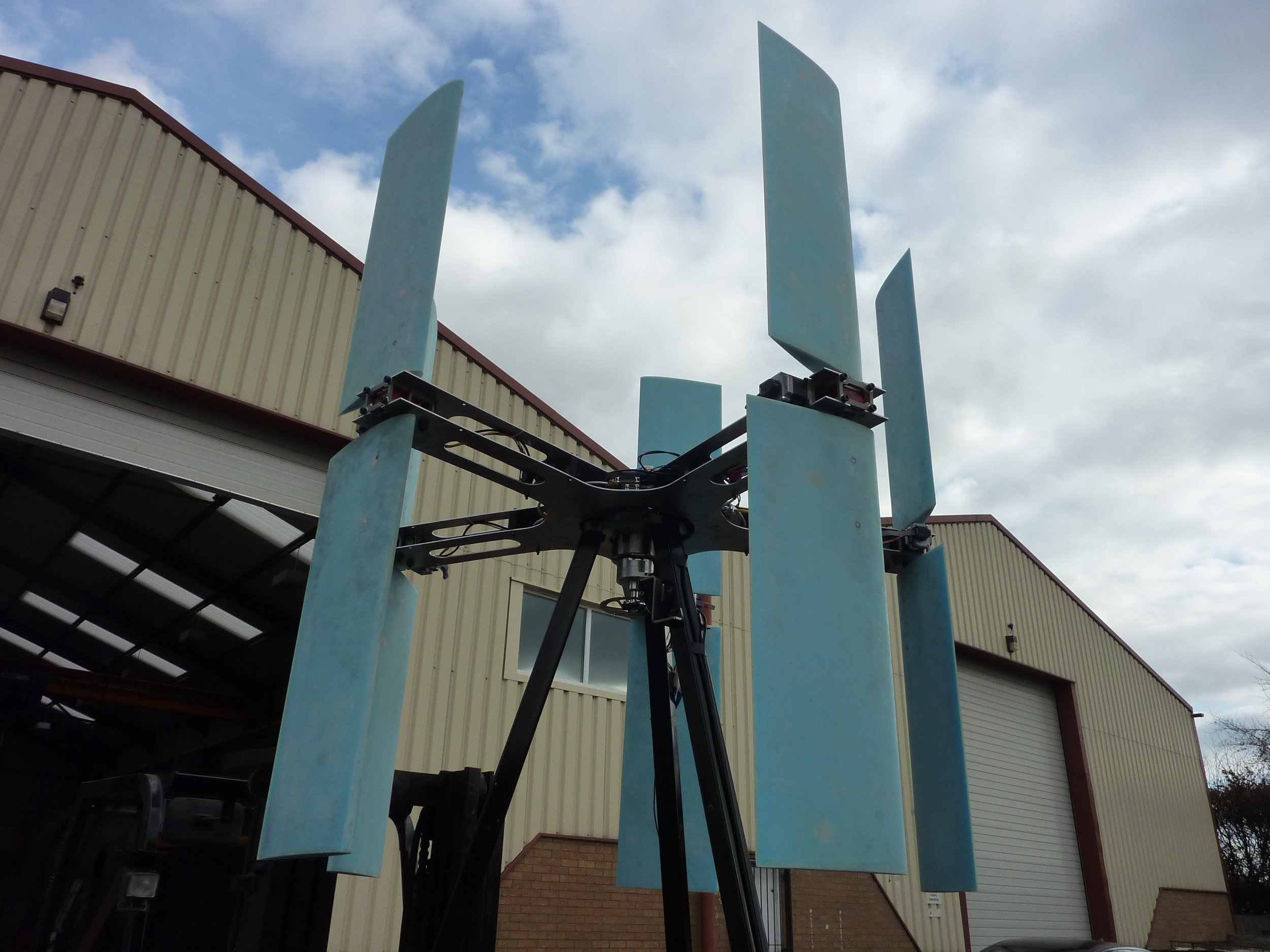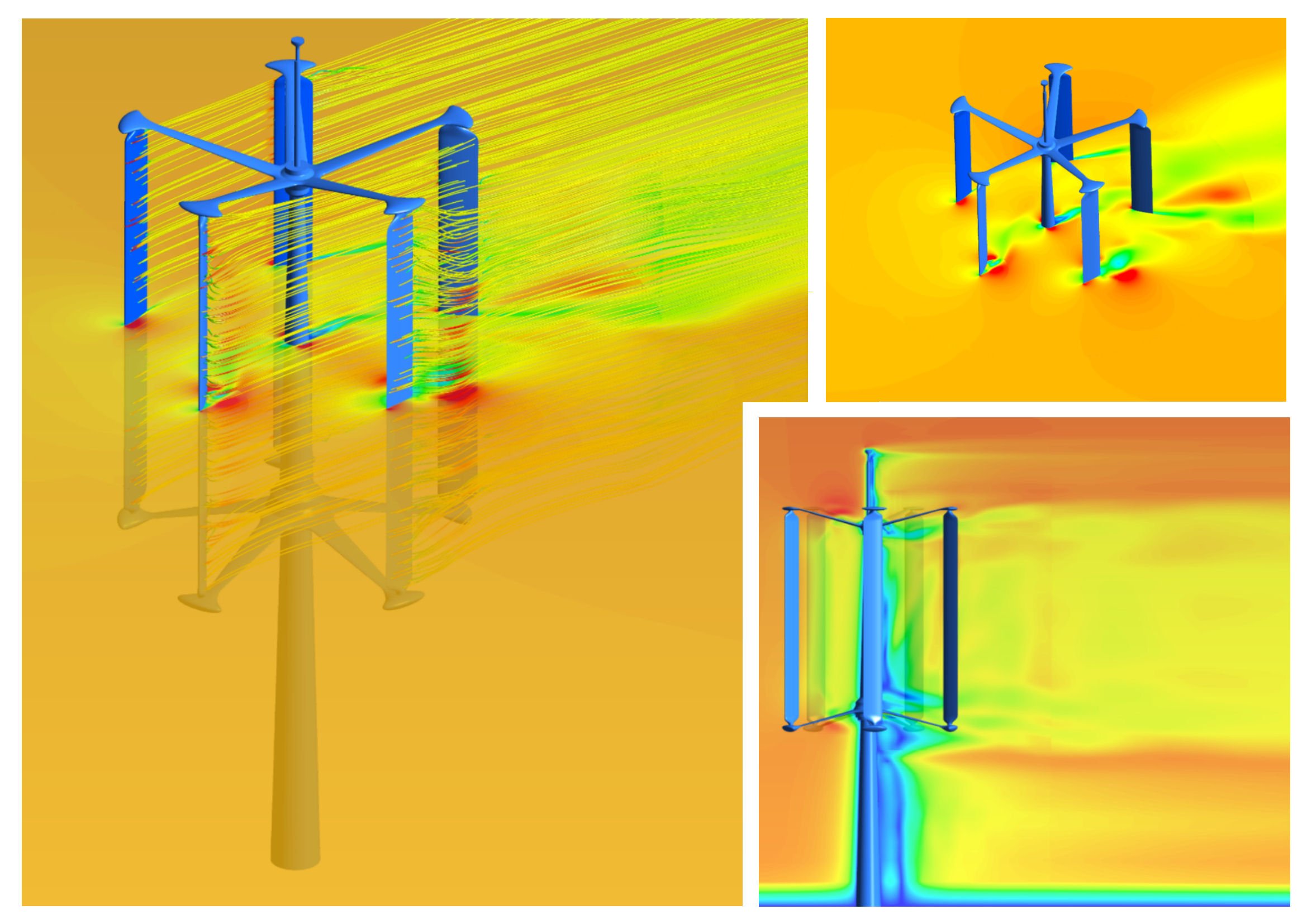Windsurf Technology Platform
Our primary initiative, the Windsurf Technology Platform, represents over a decade of research and development.
This innovative approach to energy generation, from fluid flow, utilises a vertical axis turbine with fully integrated, high-speed ‘active-pitching’ foils. This allows the turbine to adapt each foil blade independently to fluid flow conditions. The design incorporates high-speed motion control and a real-time, adaptive, algorithm which have been conceived and refined from thousands of hours of Computer Fluid Dynamic (CFD) simulations and prototype testing.
A Windsurf turbine operates much like a skilled sailor who constantly trims their sails for optimal performance. The onboard control system continuously adapts to the changing conditions to optimise power delivery and therefore financial return for the owner/operator. This unique technology results in a highly efficient, quiet, and inherently safe turbine.
Technology & Benefits
-
The active-pitching control technology at the heart of the Windsurf means that more of the available power in the wind can be harvested resulting in a turbine with industry leading output for its size.
The active-pitching control technology in Windsurf turbines enables industry-leading aerodynamic efficiency and maximizes energy capture by harvesting more of the wind's available power.
*Whilst still obeying the Laws of Physics and the Betz Limit
-
With a low operational rotation speed, direct-drive motors, no gearboxes and a ‘zero-cogging’ generator, the Windsurf is practically silent in operation. This also contributes to the low environmental impact (see below).
-
The Windsurf platform is designed such that the turbine cannot initiate or maintain rotation unless the control system is “powered” and engaged. Any event that might compromise the turbine will therefore result in the aerofoil blades becoming ‘loose’ and the turbine rotor naturally decelerating and coming to rest in a safe manner. Similar to a sailor who releases the ropes on his sails in high winds with his boat then coasting to a standstill.
-
In the event of a storm approaching, the Windsurf can simply engage the main rotor brake and let all the aerofoil blades ‘loose’. This results in each blade simply ‘flagging’ out of wind and allowing the storm to pass through without damage to the turbine structure.
This has been robustly demonstrated in the UK where storm ‘Éowyn’ blew through in January 2025 with the onboard wind sensor recording gusts in excess of 100mph.
-
The Windsurf platform contains a high level of built-in instrumentation, with feedback being continuously logged and reported back to Roth Turbines. As a result, characteristics such as gradual component wear, over time, will be evident, with preventative maintenance therefore easy to schedule to minimise downtime.
In the event of ‘unpredicted’ (accidental) damage (eg foreign object impact), this will be detected instantaneously and automatic protocols initiated. Depending on circumstances the turbine may shutdown immediately or ‘request authority’ to continue to operate under close supervision. Simultaneously any required emergency inspection and maintenance protocols will be automatically initiated.
-
The Windsurf turbine has been specifically designed with a modular approach meaning that each discrete subassembly is easy to assemble or replace as required resulting in reduced time on site for installation or maintenance.
A Windsurf turbine could be configured such that it offers a range of mounting options including surface-mounted which could then be deployed promptly without the need for extensive groundworks.
-
The core design characteristics of the Windsurf turbine mean that it can be scaled to meet any market need without a loss in performance. Roth Turbines have analysed a wide range of design variables to fully understand and document how this active-pitch vertical axis turbine can be best matched to the individual needs of any chosen market sector.
In addition, the underlying physics are just as applicable to different flow mediums.
The Windsurf technology has the scope to be deployed in anything from a small, urban wind turbine, up to a multi-megawatt, floating, offshore device. The concept would also work for a tidal flow device, operating in water rather than air.
-
The Windsurf has been specifically designed to have a high visual ‘solidity’ (a factor of both the number of aerofoil blades and the width of the aerofoil blades). This characteristic means that in operation, the Windsurf presents as more of a solid object than other comparable wind turbines and therefore this is something that any passing wildlife is more likely to choose to avoid. In combination with the lower operational speeds this means the turbine is less likely to have a negative impact on wildlife.
Since the turbine can only operate if all of the blades are engaged and actively catching the wind, the turbine could also be switched off during sensitive times of the day or year if required - seasonal migration for example.
-
Certain characteristics, inherent within the Windsurf design approach, allow for significantly reduced use of environmentally damaging composite materials (eg carbon and glass fibre) for aerofoils etc. The current WS133 turbine demonstrates this through extensive use of aluminium (one of the most recycled materials on the planet) and the entire turbine is designed to contain no fibre composite materials. This feature significantly alleviates one of the increasingly important concerns around the wind energy industry.
-
Due to the combination of vertical axis arrangement and active-pitching technology, the Windsurf is far more capable of dealing with variable airflow than existing wind turbine technology. As such, the Windsurf can be deployed at sites which might exhibit good wind profiles, but also experience too much variability in the wind for existing turbine technologies to exploit.
Brochure
Download our PDF brochure which contains features and specifications on both Windsurf technology and the WS213 Windsurf turbine. PDF (620kb)





FAQs
-
All developments should be carried out with permission from the local planning department, however the low noise signature, high visibility to wildlife and the ability to switch the turbine off during sensitive times of the day or year are all extremely favourable characteristics. This can be enhanced further by mounting the turbine onto a surface mounted base frame avoiding the need for any invasive ground works.
-
The high ‘solidity’ factor and lower rotation speeds of the turbine means that in operation it presents to wildlife as a solid object to be avoided.
-
The aerofoil blades on the Windsurf turbine travel at less than ⅓ the speed of the blade tips on conventional wind turbines. This, combined with no gearboxes and a zero-cogging generator mean that the Windsurf is a very quiet device.
-
Built up areas often create environments where the wind becomes highly variable in both speed and direction even if they exhibit an overall wind profile which is suitable for energy generation. Such an environment is too challenging for existing wind turbine technologies to operate, however, the unique active-pitching characteristics along with the vertical axis arrangement of the Windsurf means that it can cope with this variability well and therefore exploit these under utilised areas of the built environment.
-
The Windsurf can be deployed on a range of base systems to suit customer requirements.
If the surface-mounted base frame is used, it is very straightforward to break down the turbine and base, transport to another location and rebuild as required.
-
The Windsurf turbine can be deployed as a stand alone device, or integrated into part of a hybrid energy system. It can be configured to supply directly to the grid or battery storage to suit the requirements.


